Spider tortoises are not a species for beginners. They require a brumation that is an important part of their biology, for specimens of all ages and incubation is a challenge.
“Our willingness to wait reveals the value we place on the object we are waiting for.”
When Charles Stanley spoke those words, he may have had my experience with spider tortoises, Pyxis arachnoides, in mind.
We first began working with this incredible species in 2011, when a group of hatchlings arrived at our front door. Interestingly, that same year, REPTILES magazine ran an article by Dr. Will Ahrens on spider tortoises that remains the most comprehensive work on the husbandry of the genus in the English language. Before that, a brief care sheet written by the legendary Dr. William Zovickian was all keepers had to look to for guidance. In 2018, a wonderful piece written for REPTILES by Dr. James Liu rounded out what is a small but mighty collection of resources on the captive care of the spider tortoises.
The years since those early days have fittingly been a slow crawl for us, aided greatly by this very publication. The spider tortoise, even by the slow-and-steady standard set by chelonians in general, is a tortoise that despite its small adult size, takes a very long time to mature. Even with accelerated growth rates due to ideal captive diet and conditions, spider tortoises in our care take eight to 11 years to reach maturity. While this is not unrivaled in the turtle and tortoise world, it is noteworthy compared to most reptile species and even most small chelonian species. Leuteritz and Walker wrote that the spider tortoise takes 12 years to become sexually mature, but the average age of reproduction is closer to 20 years of age.
Trust the Process
The group in our care had been raised with thoughtful care for more than a decade, hoping that one day, that care would pay off in the form of new spider tortoise life. This species is listed as critically endangered by the International Union for Conservation of Nature (IUCN) and some estimates by those working with the species in the wild suggest that the species may be extinct in the wild within the lifetime of a single tortoise, 60 to 80 years. Only 30 percent of the historical population is thought to remain.
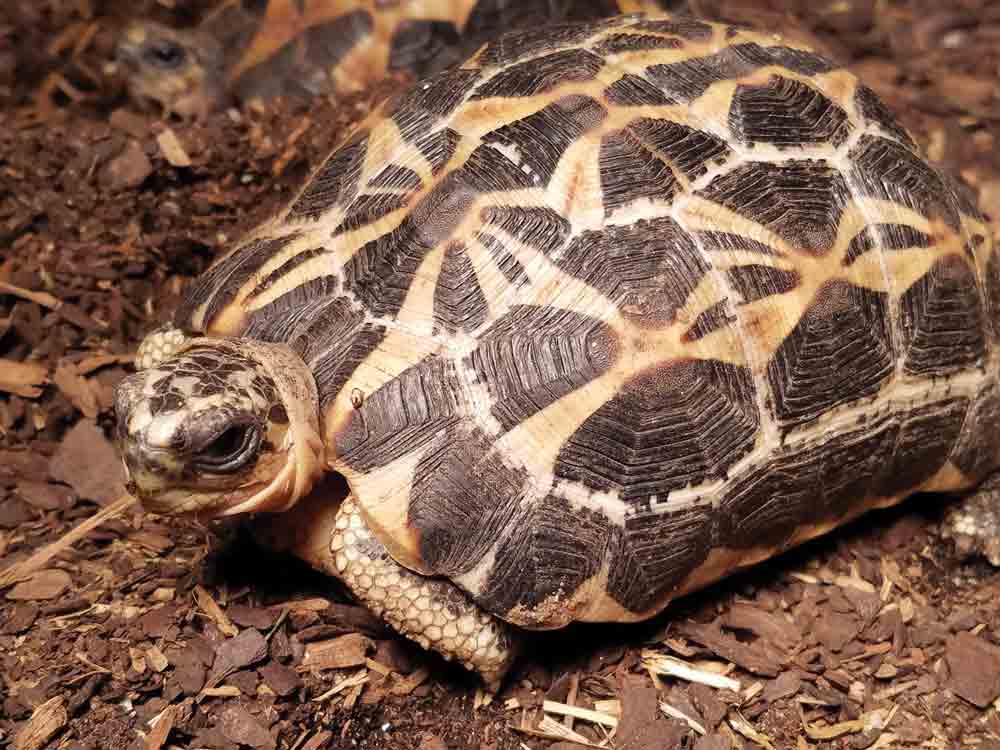
The substrate blend the authors use is a mixture of topsoil, peat moss, sand, and cypress mulch. Photo by Anthony Pierlioni
Spider tortoises are not a species for beginners. They require a brumation that is an important part of their biology, for specimens of all ages and incubation is a challenge. They are also rare in captivity, no longer being imported and being bred only rarely. While successful efforts by some have been successful and steady, it has not been enough to meet the demand.
Their rarity makes it imperative that all animals are part of a breeding program to ensure this species has a future on earth. When we look at species like McCord’s box turtle, Cuora mccordi, the Vietnamese pond turtle, Mauremys annamensis, the Kwangtung River turtle, Mauremys nigricans, and the Burmese star tortoise, Geochelone platynota, we see animals that are functionally extinct in the wild and that would be virtually gone from the planet if not for captive breeding. In fact, many of the aforementioned species have benefitted specifically from breeding efforts of private individuals.
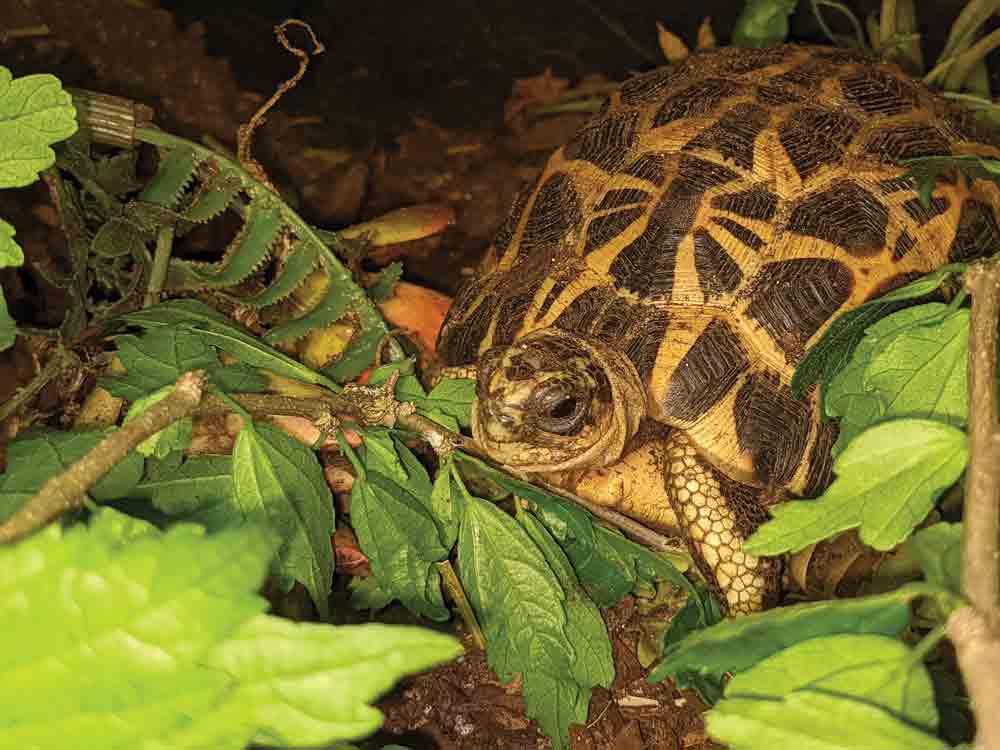
A young spider tortoise eating some green leaf lettuce. Photo by Anthony Pierlioni
With all of this being said, many keepers have tried their hand at keeping spider tortoises, only to decide that the species was not for them. The long wait for breeding activity, rarity of females in captive populations, and the relative inactivity of the species compared to other tortoises create buyer’s remorse for many keepers. We will cover many of these items in more depth later in this article.
Description
Spider tortoises are a small (generally under 6 inches) species of chelonian that is named for the spider web-like pattern created by the markings on their shell. Yellow or tan markings on a black background are present, much like that of star, Geochelone species, and other taxa. This intricate and high contrast coloration aids in camouflage. It can be difficult to wrap your head around how successful this strategy can be for blending in with the environment when these animals are kept indoors and/or in an unrealistic environment.
However, when tortoises with such a pattern are hiding amongst grasses, they become almost completely hidden. Coloration can differ greatly from one specimen to another, even with two animals of the same subspecies.
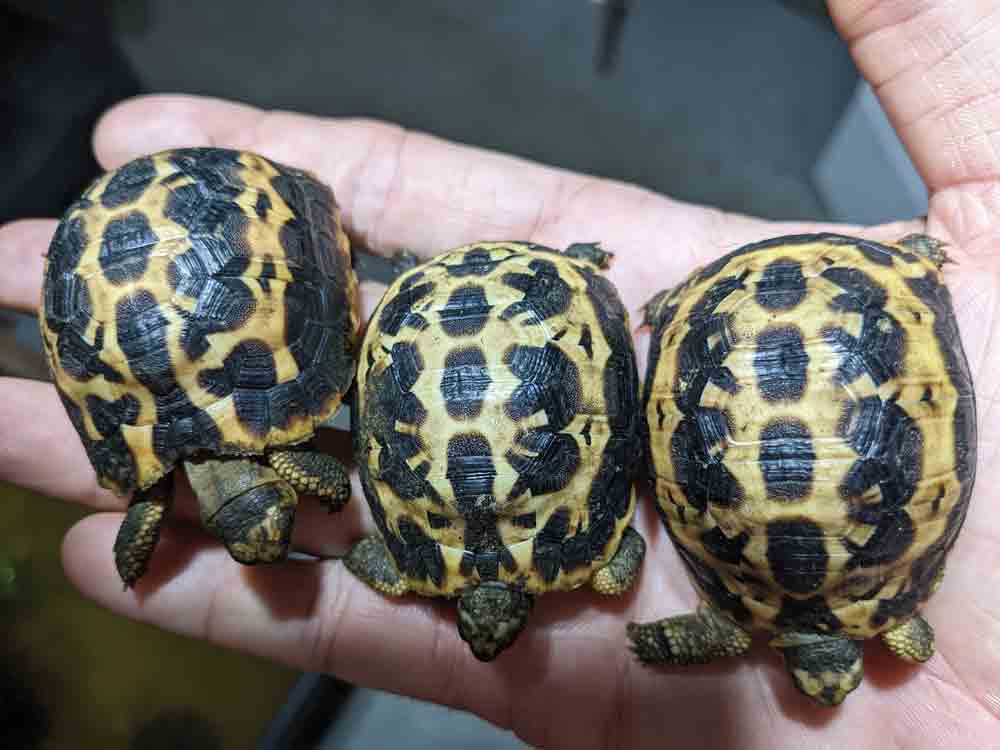
The spider tortoise is no longer being imported and are rarely bred. These chelonians are for expert keepers. Photo by Anthony Pierlioni
Spider tortoises are split into three subspecies that appear very similar at first glance. Each subspecies has a distinct plastral feature that distinguishes it from the others. The common spider tortoise, Pyxis arachnoides arachnoides, has a plastron with a hinge and is completely devoid of markings. The plastron of P. a. brygooi also has no markings, but this subspecies lacks the hinge that the nominate subspecies possesses. Lastly, P. a. oblonga, the rarest of the Pyxis in captivity, has black markings on the plastron, generally located near the bridges.
Range
The spider tortoise is native to a small length of spiny, deciduous forest that curves around the southwestern coast of Madagascar. The three subspecies are geographically divided from one another across the range. The Northern spider tortoise, Pyxis arachnoides bygooi, lives in the northernmost part of their range, which is located just south of Morombe. The common spider tortoise, Pyxis arachnoides arachnoides, occupies the middle of the species range, around and south of Toliara. The range of the Southern spider tortoise, Pyxis arachnoides oblonga, spans the southern tip of Madagascar.
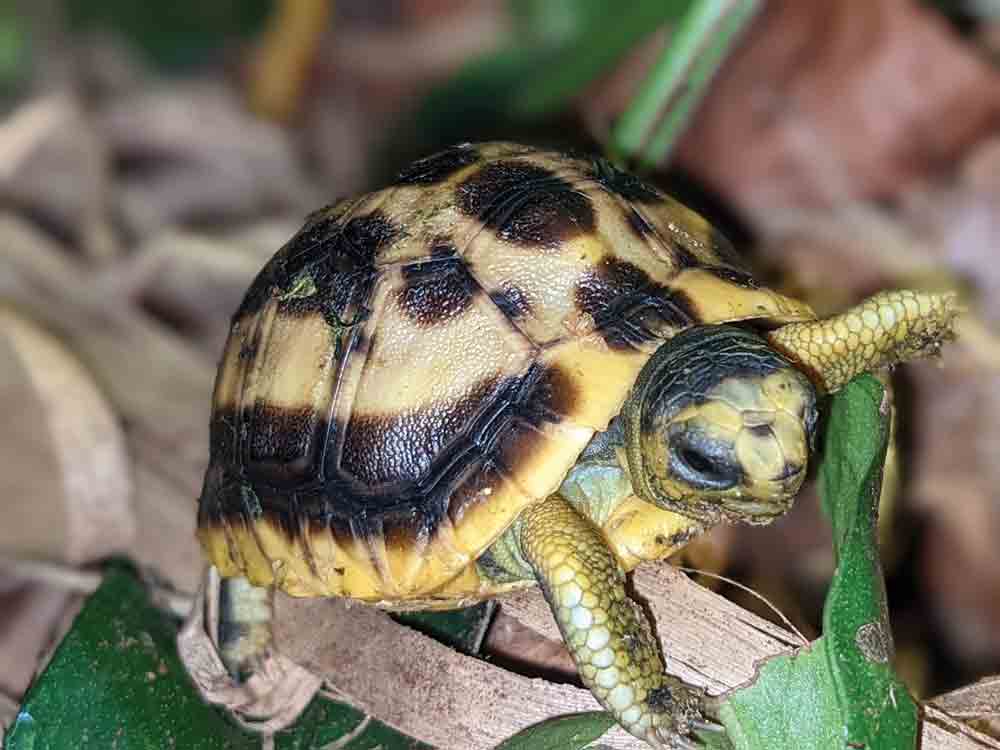
Spider tortoises rarely exceed six inches in length. Photo by Anthony Pierlioni
Spider tortoises experience a wet or monsoon season where their activity levels increase greatly. In the dry season, the animals become inactive. This is a behavior observed in captivity, as well. Zovickian reported that these tortoises may experience temperatures ranging from a low of 43 degrees Fahrenheit (6 degrees Celsius) to a high of 108 degrees Fahrenheit (42 degrees Celsius) in their natural range. The average temperatures range from 58 degrees Fahrenheit (14 degrees Celsius) to 92 degrees Fahrenheit (33 degrees Celsius) and average relative humidity is 78%. They seem to prefer temperatures in the low 80s. (27 to 29 degrees Celsius)
History in the Hobby
Spider tortoises were commonly available to serious collectors around the turn of the century. At that time, adult animals were what was being offered for sale and many keepers jumped at the chance to work with this beautiful species. Those animals needed to acclimate to captivity and the process was not always easy. Imagine taking an animal that is very cryptic in nature and essentially asking it to change its calendar and go to sleep for half of the year when it just spent half of the year sleeping in Madagascar. This was the challenge at that time with imported spider tortoises.
Today, spider tortoises are no longer imported, due to its listing as a CITES I species. In 2013, the species was petitioned for listing under the Federal Endangered Species Act (ESA), which makes little sense considering that would limit the interstate movement of captive born animals, while virtually no wild-caught Pyxis are being sold in the US, legally or otherwise. While the species is not produced enough to meet demand, this story is a positive one, where spider tortoises are produced every year and wild-caught animals are no longer imported or even smuggled into the country.
Threats
Wild spider tortoises continue to face a myriad of threats to their ultimate survival in the wild. Agriculture, charcoal production, human-induced wildfires, and invasive plants have all played a part in significantly altering the habitat for this species.
Captive Care
Spider tortoises are one of the easiest species to keep. Many keepers refer to them as “pet rocks,” or “pretty rocks,” because of their low activity levels compared to other, more commonly kept species. Spending half the year almost completely inactive as well as a large portion of every day, is not for everyone. Their rarity, low fecundity, and high cost also means they will never be a staple in captive collections.
The ease of keeping them is attributed mostly to their seasonality and the fact that they get along so well in groups. Many species are kept in groups in captivity because that is easiest for keepers, but often comes at a cost, be it stress or even injury related at times. With spider tortoises, stress and aggression are not a concern for keepers. The seasonality that makes them boring for some, is what makes them a great candidate species for indoor keeping in areas where temperatures and humidity vary during the course of a year.
Our first, main group of spider tortoises were set up in a medium Waterland Tub (70”L x 32”W x 14”H) as soon as we brought them into our collection. The small tortoises looked lost in the enclosure, but seemed to enjoy the expanse and how the larger space allowed for a considerable temperature gradient across their habitat. Today, the group remains in the exact same enclosure as adults, with not a single sign of aggression in all of those years.
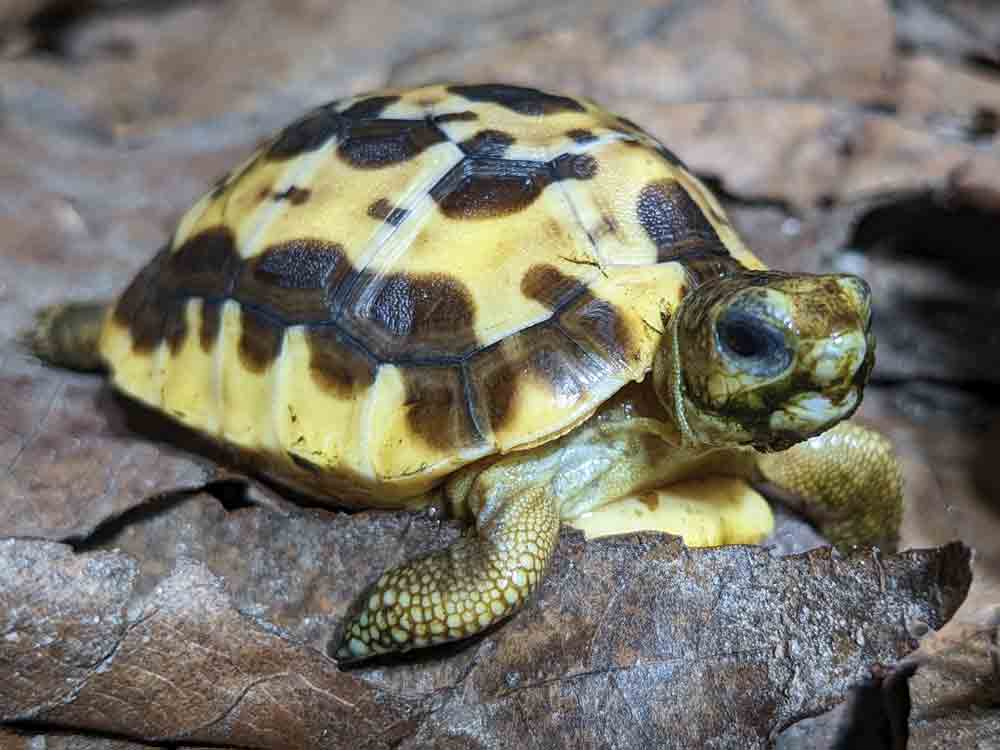
Spider tortoises can live together regardless of sex, size, age or maturity. Spider tortoises are voracious eaters. Photo by Anthony Pierlioni
The substrate blend we use is a mixture of topsoil, peat moss, sand, and cypress mulch. Isopods and springtails in the enclosure help to break down what little waste the tortoises produce.
A shallow water dish is provided to prevent flips and offer a constant hydration source. Live plants including edible succulents are often added but only last so long in our basement as the tortoises trample them over time. Keeping live plants in pots can help, but we also use fake plants to provide cover for the tortoises and a naturalistic look.
Cork bark hides are used, but the tortoises prefer to simply bury themselves into the substrate, especially during the dry season.
Temperatures have been allowed to naturally fluctuate in the basements in which these animals have been kept. The mercury vapor bulb they are provided with takes the summer warmth up a notch and in the winter, the same bulb provides a small amount of basking area in a large expanse of an enclosure for these small tortoises. The basking area is not used by adult animals during the dry season, as the tortoises opt instead to bury themselves and stay cool, or even cold – as low as the 50s in the dead of winter.
Captive Diet
We offer our spider tortoises a variety of food items and believe that variety benefits them greatly, as it does any chelonian. Leafy items like dandelion, escarole, chicory, green and red leaf lettuce, Boston lettuce, romaine, plantain, clover, grape leaves, and hibiscus leaves are all offered and relished. Vegetables like zucchini, summer squash, sweet potato, and carrot are blended in a food processor and added. Zoo Knoxville, the best institutional breeder of this species in the world, feeds spider tortoises on large collard greens leaves that act as edible plates for the food.
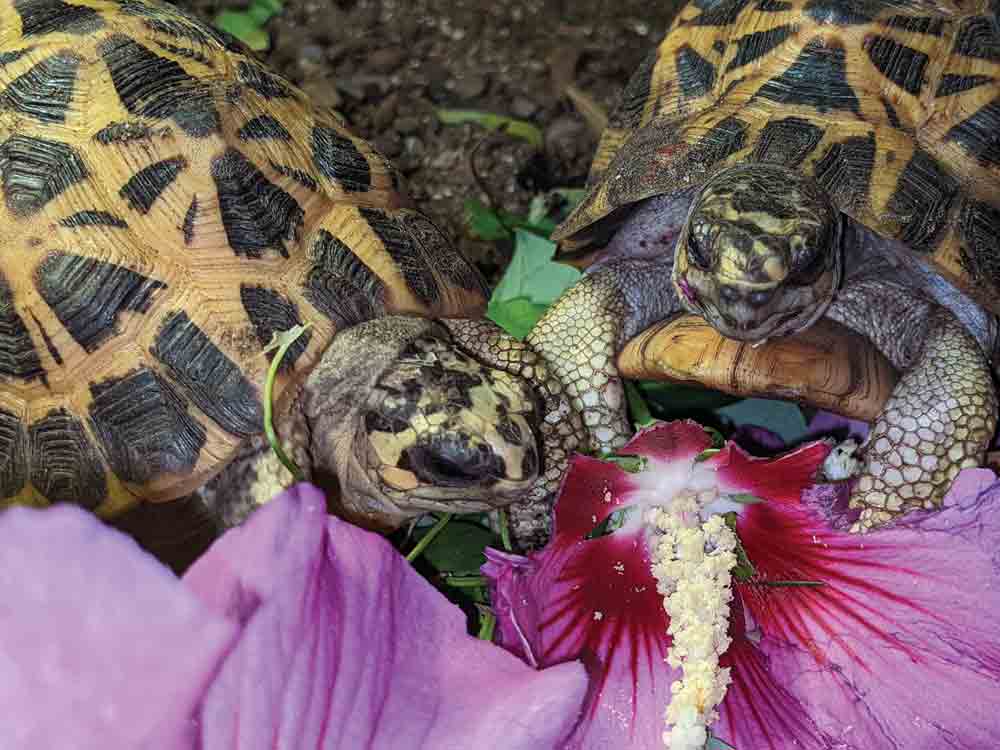
Leafy items like dandelion, escarole, chicory, green and red leaf lettuce, Boston lettuce, romaine, plantain, clover, grape leaves, and hibiscus leaves are all offered and relished. Photo by Anthony Pierlioni
In our experience, two food supplements have been instrumental in the health of our group. The species seems to benefit greatly from the addition of mushrooms in their diet. We have offered white button mushrooms and portobello caps with great success. The other item that has really helped as a supplement is Mazuri Tortoise Diet. This product, when moistened, is a pungent, nutritious, and hydrating food item. We originally started using it when we had small tortoises that were not growing over the course of several months. Once Mazuri was introduced, steady growth commenced.
Spider tortoises are voracious eaters in the active season and mushrooms and Mazuri help make those precious growing seasons count. Many keepers offer fruit to their spider tortoises with success, but we do not include any fruit in their diet, as it is not a part of their natural diet. Prickly pear cactus, Opuntia sp. are offered by many keepers, and while these cacti do live in Madagascar, they were likely only introduced around 300 years ago and were surely not a part of the evolution of spider tortoises, so we generally do not offer it. We do propagate and offer succulent plants like Sedum and Graptopetalum.
Cool for Comfort
Spider tortoises need to brumate every year. In fact, they go almost completely dormant for almost half of the year. Keepers in warmer climates may only see their animals go dormant for three to four months, but here in a more temperate climate, we see our spider tortoises remain inactive for roughly five months out of the year.
During the inactivity period, spider tortoises will bury themselves in the substrate and will usually stay that way, even when sprayed. Food is offered one to two times a week during this time, but is generally not touched. Animals can be collected and bathed during that time of year and at that time they will drink. They often eat immediately following these dry season baths but then it is right back to dormancy.
A small amount of weight loss during this time of year is normal, perhaps up to 10 to 15 grams for adult tortoises. Weight is generally pretty steady during this time, however, causing growth charts for maturing spider tortoises to look like a staircase. They grow rapidly during the warmer monsoon season and cease growth during the cooler dry season.
Breeding and Incubation
Spider tortoises are not a species that exhibits any kind of fecundity. They are slow to mature and produce only one egg at a time, except for the extremely rare two-egg-clutch. That being said, when a group of adults settles into their environment and is comfortable and healthy, they can become steady breeders that produce on a somewhat predictable schedule, with eggs being laid every month or so.
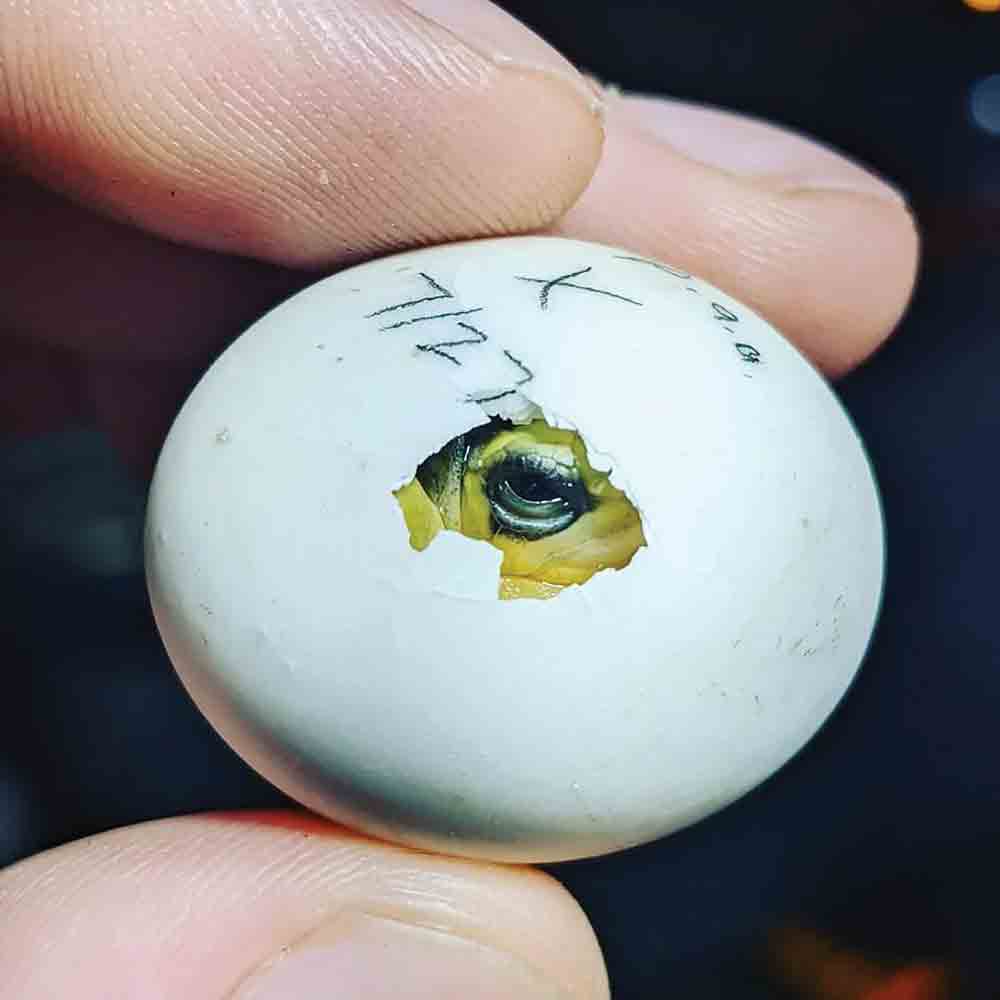
Spider tortoise eggs need to go through a diapause, where development is suspended due to suboptimal environmental conditions during incubation. Photo by Anthony Pierlioni
Eggs are generally large, compared to the size of the female, and are often situated just to the side of the area where you would expect to find them after observing a female nesting. Just before oviposition, the posterior portion of the female’s shell becomes pliable to allow for the passing of the large egg. The clutch size is almost always one egg, with the very seldom two egg clutch being possible.
Spider tortoise eggs need to go through a diapause, where development is suspended due to suboptimal environmental conditions during incubation. Eggs are laid late in the season, from late summer to early winter here in the northern hemisphere. We have been successful when warming (roughly 85 degrees Fahrenheit or 29.4 degrees Celsius) the eggs for four weeks, then cooling (between 68 and 73 degrees Fahrenheit or 20 and 22.8 degrees Celsius) them for four weeks, and returning the eggs to the incubator to be kept warm again through the duration of incubation.
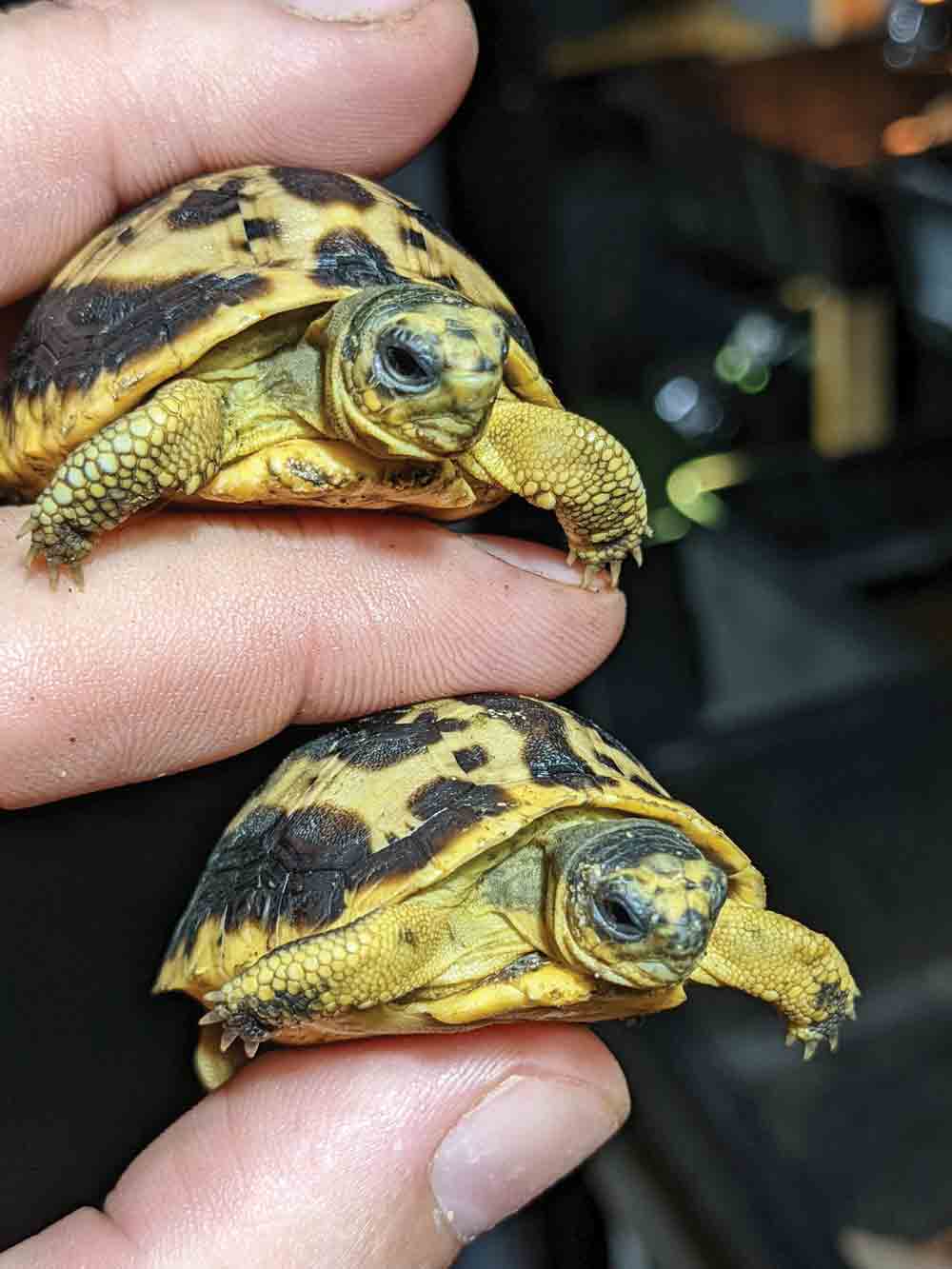
A pair of hatchling spider tortoises. Photo by Anthony Pierlioni
Pearson suggests each of the first two phases of artificial incubation should last four to six weeks, but we are impatient and have stuck to the lower end of those ranges with success. Some keepers suggest that the first warm period may not be necessary, particularly for eggs laid later in the season, when conditions are cooler and drier. We have chosen to use the initial warm period. Occasionally, eggs need a second diapause if development does not begin at the normal moment after the second warm up starts. To cool eggs, some keepers use wine chillers, but we simply place the eggs in a cool spot near the floor of our turtle room.
Hatchling Care
We place our hatchlings in six-quart Sterilite tubs that are situated within a larger enclosure that is controlled by a thermostat. Lighting is situated above and a small radiant heat panel kicks on when the temperature drops.
This closed chamber system keeps the humidity high and provides a secure environment where young tortoises can thrive. Paper towels are used in lieu of loose substrate, as the high humidity can create muddy conditions when traditional substrates like that used for the adults are used.
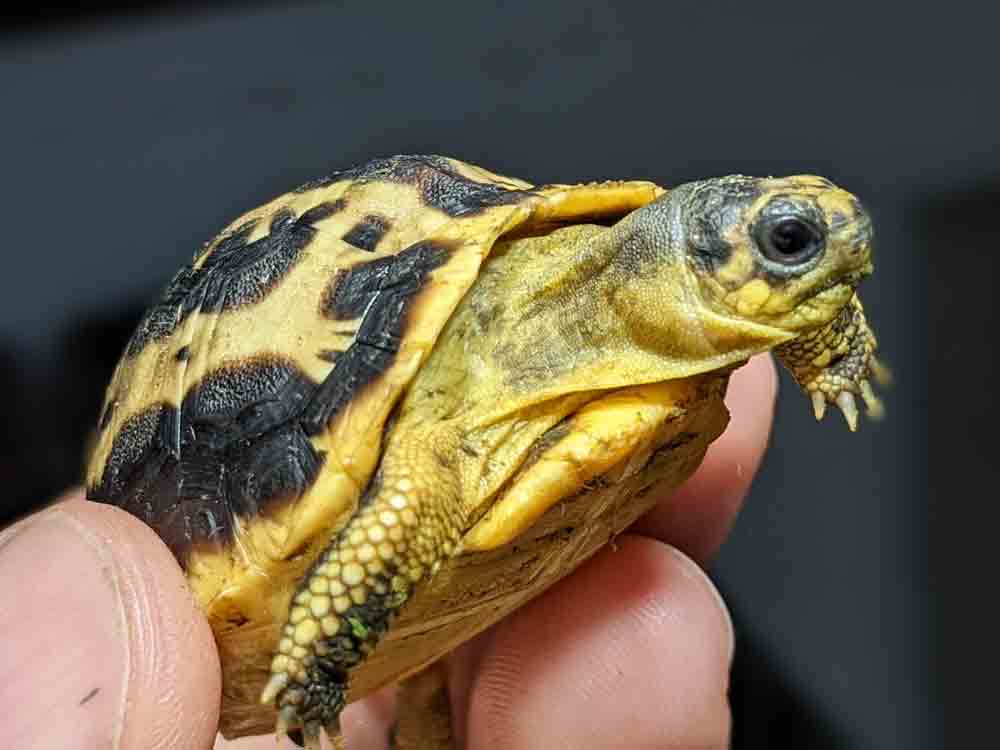
The spider tortoise takes a very long time to mature in spite of its small size. Photo by Anthony Pierlioni
Hatchlings are provided the same food as the adults, chopped more finely to allow for easier feeding. Neonate tortoises can struggle with leafy food items when they become more rubbery and less crisp after some time in the humid environment in which the tortoises live.
Frequent bathing is also a must. It would be difficult to find any tortoise that likes to drink water as much as spider tortoises, and this behavior starts when they hatch. Make it a point to offer the young tortoises quick baths in warm water throughout the week. You will notice the tortoises extending their necks and drinking with great intention.
Cohabitation
Perhaps the most desirable factor when a keeper considers working with an important species like the spider tortoise is the idea of stress and related space requirements. Many keepers flock toward small species, for obvious space constraint related reasons, only to realize later in their research that the species they are considering does not cohabit well. Stress is likely the leading cause of health concerns for most animals.
Spider tortoises are one of the true exceptions to this rule, as they live together in harmony regardless of their age, size, sex, or maturity status. Our group has lived together in the same enclosure since they came here more than 11 years ago.
Anthony Pierlioni is the vice president of theTurtleRoom, an international turtle conservation organization. He keeps and breeds numerous endangered species of turtle and tortoise and works to educate the public about their plight. Anthony’s book on Leaf Turtles was published in 2016. He is also the host of the “Pondcast,” a show dedicated to reptiles and the people who love them, and “Turtley Devoted,” which looks at the relationship between reptile lovers and the people who put up with them. Follow him on Instagram and FaceBook.

